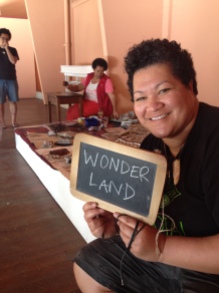#TheVeiqiaProject in Fiji, September 2015
Back in Suva stomping old ground, learning a lot and feeling so excited for The Veiqia Project! So gloriously un-academic, and safe from territorialism, this trip has been deeply inspiring…
The Veiqia Project is a creative research project investigating the practice of Fijian female tattooing; it will culminate in an exhibition due to open at Auckland’s St Paul St Gallery 3 in March 2016, timed to coincide with the Pacific Arts Association XII International Symposium and Auckland Arts Festival. The exhibition will feature new work by seven contemporary artists from Australia and New Zealand. Through a shared online research forum and time spent with Fijian collections at museums in Australia, Fiji and New Zealand, the artists have generated an indigenous research archive driven by personal, artistic and relational connections.
A significant Creative New Zealand grant enabled New Zealand-based artists Margaret Aull, Joana Monolagi, Luisa Tora and myself to travel to Suva to meet Australia-based artist Dulcie Stewart and co-curator, Tarisi Vunidilo, to conduct research at Fiji Museum, host two public events, meet and hear stories from a broad range of artists, experts and academics. A special invitation was extended to Darwin-based tatu artist / film maker / choreographer, Julia Mage’au Gray, who contributed knowledge and insights on tattoo design, protocols, inspiration and the wider globalised challenges of appropriation and intellectual property protection.
This week, we all start to trace the well-worn paths back to our diasporic other-lands. The Veiqia Project has been grounded and expanded, it has become a catalyst and a trigger, a call to action and a gentle reminder that this particular approach to creative research is tangible and social, genuine and emotional, intersectional and multidimensional… and not at all academic.
Thank you to our project partners: Creative New Zealand, Fiji Museum, Fiji National University School of Creative Art, Sangeeta Singh Photography. Thank you to our friends and families who have fed and watered us, driven us around and lent us cars, cameras, drawing skills. Thank you to the staff at the Fiji Museum, especially Mere, Mereia, Prakashni, Ratu Sela, William, Raijeli and Elenoa. Vinaka Jane Ricketts and the resident artists at Tagimoucia Gallery. Thank you Twitter fams, @gurumi, @sharky_fj and @fijiandiva104! We are all truly grateful!
v i n a k a v a k a l e v u























